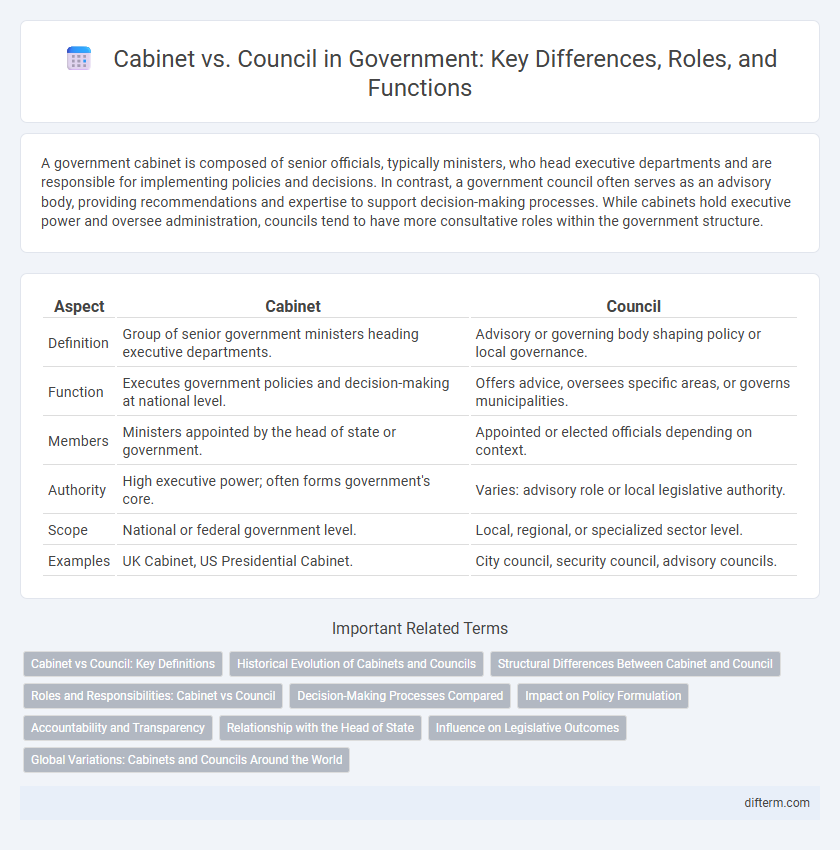A government cabinet is composed of senior officials, typically ministers, who head executive departments and are responsible for implementing policies and decisions. In contrast, a government council often serves as an advisory body, providing recommendations and expertise to support decision-making processes. While cabinets hold executive power and oversee administration, councils tend to have more consultative roles within the government structure.
Table of Comparison
| Aspect | Cabinet | Council |
|---|---|---|
| Definition | Group of senior government ministers heading executive departments. | Advisory or governing body shaping policy or local governance. |
| Function | Executes government policies and decision-making at national level. | Offers advice, oversees specific areas, or governs municipalities. |
| Members | Ministers appointed by the head of state or government. | Appointed or elected officials depending on context. |
| Authority | High executive power; often forms government's core. | Varies: advisory role or local legislative authority. |
| Scope | National or federal government level. | Local, regional, or specialized sector level. |
| Examples | UK Cabinet, US Presidential Cabinet. | City council, security council, advisory councils. |
Cabinet vs Council: Key Definitions
The cabinet is a core group of senior government ministers responsible for making major policy decisions and implementing executive functions, while the council typically refers to a broader advisory or decision-making body that may include members outside the executive branch. Cabinets are central to parliamentary systems and consist primarily of heads of ministries, whereas councils can vary in composition and purpose, often providing recommendations or governance at local, regional, or organizational levels. Understanding the distinction between cabinet and council is essential for grasping the structures of government authority and policy execution.
Historical Evolution of Cabinets and Councils
The historical evolution of cabinets and councils reflects distinct governance structures shaped by political and cultural contexts. Cabinets originated in British constitutional monarchy as a group of senior ministers advising the monarch, gradually assuming executive power during the 18th and 19th centuries. In contrast, councils have ancient roots as advisory or decision-making bodies in monarchies and republics, often encompassing broader membership and evolving into specialized institutions like councils of state or advisory councils in modern governments.
Structural Differences Between Cabinet and Council
The cabinet typically consists of senior government ministers selected by the head of government, responsible for making executive decisions and implementing policies. In contrast, a council often serves as a broader advisory or administrative body, which may include appointed or elected members representing diverse interests or regions. Structurally, cabinets are centralized with concentrated decision-making authority, while councils operate through collective deliberation and consensus-building processes.
Roles and Responsibilities: Cabinet vs Council
The cabinet primarily consists of senior government ministers responsible for formulating policies, overseeing government departments, and making executive decisions to implement legislation. In contrast, the council functions as an advisory or deliberative body, providing recommendations, guidance, and oversight but lacking direct executive power. Cabinet members hold collective responsibility for government actions, whereas councils focus on consultation and community or sector-specific representation.
Decision-Making Processes Compared
Cabinets typically consist of senior government ministers who hold executive authority to make binding decisions on national policies and administration, streamlining fast and centralized governance. Councils, often larger and more inclusive, function primarily as advisory bodies that deliberate on various issues, offering recommendations without direct binding power. The decision-making process in cabinets is characterized by collective responsibility and confidentiality, whereas councils emphasize consensus-building and transparency through broader stakeholder engagement.
Impact on Policy Formulation
The cabinet plays a central role in policy formulation by making key decisions and setting government priorities, directly influencing legislative agendas and resource allocation. Councils, often advisory bodies composed of experts or representatives, provide specialized insights and recommendations that shape the policy development process but lack formal decision-making authority. The dynamic between cabinet decision-making power and council advisory input enhances the quality and effectiveness of government policies.
Accountability and Transparency
Cabinet members are directly accountable to the head of government and the legislature, ensuring decisions are transparent through parliamentary oversight and public reporting. Councils, often advisory bodies, lack the same level of direct accountability but contribute to policy transparency by providing expert recommendations and stakeholder consultations. Effective governance requires clear delineation of responsibilities within cabinets and councils to maintain public trust and institutional transparency.
Relationship with the Head of State
The cabinet is a body of high-ranking government officials, typically appointed by and serving at the pleasure of the Head of State, who often presides over or formally approves its decisions. The council, such as a Privy Council or advisory council, functions primarily as an advisory group that provides counsel directly to the Head of State but does not usually exercise executive power. The cabinet manages daily governance and policy implementation, while the council's role centers on advising the Head of State on constitutional or ceremonial matters.
Influence on Legislative Outcomes
The cabinet wields significant influence on legislative outcomes by proposing bills and setting policy agendas aligned with the executive branch. In contrast, the council often serves as an advisory or deliberative body, providing recommendations and oversight rather than directly shaping legislation. Cabinet members typically hold ministerial portfolios, enabling them to negotiate and drive legislative priorities within the parliament.
Global Variations: Cabinets and Councils Around the World
Cabinets and councils vary globally in structure and function, with cabinets typically serving as executive decision-making bodies composed of ministers responsible for specific government departments. In parliamentary systems like the United Kingdom, the cabinet exercises collective responsibility and directs national policy, while in federal systems such as India, both central and state councils exist with distinct roles. Councils often represent advisory or administrative groups, such as the State Council in China, which functions as the chief administrative authority under the central government.
cabinet vs council Infographic

 difterm.com
difterm.com